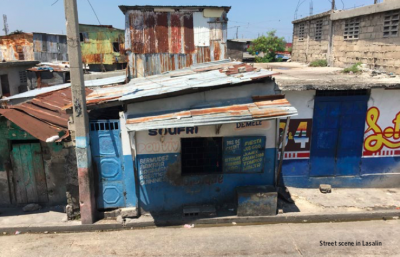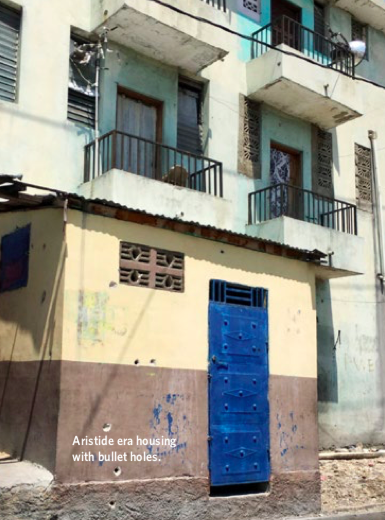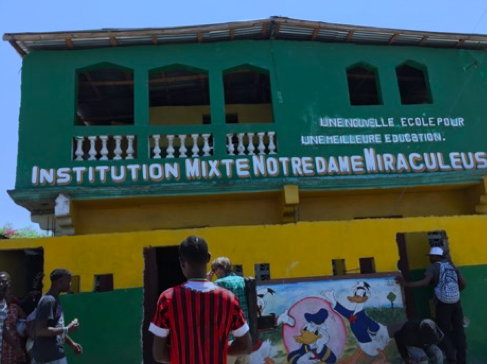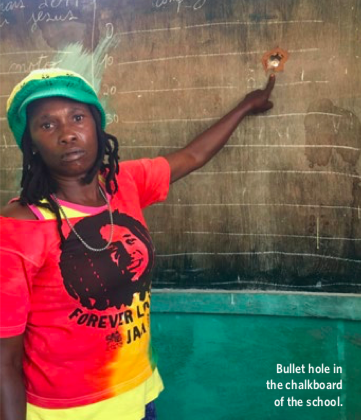The Lasalin Massacre and the Human Rights Crisis in Haiti

All Global Research articles can be read in 27 languages by activating the “Translate Website” drop down menu on the top banner of our home page (Desktop version).
***
Introduction
On November 13, 2018, police and other paramilitary personnel entered the neighborhood of Lasalin in Port-au-Prince, Haiti. What followed was a massacre of the civilian population. Buildings, including schools, were fired upon and destroyed, people were injured and killed, with some burned alive, women were sexually assaulted and raped and hundreds were forcibly displaced from homes. Bodies were either burned, taken away to be disappeared, buried, never to be found, or in some cases left to be eaten by dogs and pigs.
There has been widespread acknowledgement from the Haitian government, mainstream human rights groups and even the United Nations occupiers in Haiti, known by the acronym MINUJUSTH, that something terrible took place in Lasalin. However, in every case, there has been an attempt to downplay and obscure what actually happened. The numbers of the dead and wounded have been minimized, the extent of destruction to communities and displacement downplayed, and the violence has been primarily blamed on “gangs fighting over territory.”
The Lasalin massacre was designed to punish and destroy a neighborhood long known as a stronghold of the grassroots Lavalas movement and center of opposition. Our investigation determined that the narrative of “gang warfare” obscures the reality that the attack on Lasalin was government-orchestrated and supported, with police collaborating with and weaponizing criminal elements. According to many Lasalin residents and survivors, the coordinator of the massacre was Pierre Richard Duplan, alias Pierrot, of the PHTK (Parti Haïtien Tèt Kale, the ruling party of Jovenel Moise). Duplan had failed in his bid to become the mayor of Port-au-Prince and was now the government delegate for the West Department of Haiti.[1] A UN human rights report released on June 21st, 2019, also implicates Duplan.[2] The Miami Herald disclosed in a May 15th article that a police investigation had confirmed the involvement in the massacre of high-level government officials in the government of Jovenel Moise, tracing an assault rifle assigned to the National Palace to the massacre[3] These are just some of the examples of government involvement in the massacre.
On April 1, 2019, members of the Haiti Action Committee (HAC) and the National Lawyers Guild (NLG) went to Haiti to investigate the November 13th massacre in Lasalin as well as the ongoing pattern of repression and extrajudicial killings targeting the people of Lasalin and other neighborhoods known for their activism against the government. We found a clear pattern of paramilitaries/death squads being armed and abetted by the government in order to terrorize the population and prevent opposition. This level of violence and repression has not been seen since the 2004 coup against President Aristide which, according to a study published in the medical journal The Lancet, resulted in an estimated 8,000 deaths in the Port-au-Prince area alone.[4]
Our team included Judith Mirkinson, President of the San Francisco Chapter of the National Lawyers’ Guild; Margaret Prescod, producer of the “Sojourner Truth” radio program nationally syndicated on Pacifica Radio and member of Women of Color/ Global Women’s Strike; Ramiro Funez, assistant producer of “Sojourner Truth”, and Seth Donnelly, member of Haiti Action Committee and the California Teachers Association. Margaret Prescod provided coverage of our delegation’s findings on “Sojourner Truth” and on “The Real News Network” television program.[5]
Report Methodology
On April 1, 2019, our team went to Lasalin and conducted interviews with residents who had witnessed the killings and/or who had lost loved ones in the massacre. We also gathered physical evidence of the killings. That same afternoon, we went to an abandoned market in Waf Jeremy and interviewed some of those residents who had been forced to flee from their homes in Lasalin.
We followed up these direct interviews on April 2nd by speaking to Haitian investigative journalists who had been closely following the situation in Lasalin, from before the massacre to the present day. We also met with Haitian human rights workers.
After our visit, another U.S. human rights delegation went to Haiti between April 24th and April 27th to follow up on our investigation. This second delegation included U.S. Representative Maxine Waters, investigative journalist Margaret Prescod, Haiti Action Committee co-founder Pierre Labossiere, actor Danny Glover, and NLG human rights attorneys Walter Riley and Brian Cocannon. The additional evidence gathered by this second delegation confirms the findings of this report.
As Walter Riley expressed:
“We have eyewitness reports that these attacks are not simply gangs as they are being referred to by the press and the US Embassy, but part of militias backed by some in the Moïse administration. The murder and brutality is a policy of the Haitian government which is backed by the United States.”
Similarly, Brian Concannon stated:
“I have worked on political violence cases in Haiti for 24 years and the witness reports from Lasalin, Tokyo and Site Vincent are all too similar to other notorious acts of state-sponsored oppression … With the Duvaliers’ Ton- Ton Macoutes, the FRAPH death squads and now the violent groups under the Moïse administration, the motive for each has been silencing calls for justice and democracy and terrorizing government opponents, while disguising government participation.”[6]
Congresswoman Waters said she was ‘appalled and shocked’ at the killings and promised to engage with her colleagues in Congress to use ‘whatever leverage and power we have to help make the violence cease because this is not conscionable and not tolerable.’”[7]
In addition to the information collected from these steps and sources, we have also read and analyzed reports by Haitian human rights organizations on the November 13th massacre. Furthermore, we have extracted corroborating evidence for our findings from investigative Haitian journalists and from a public interview with one of the key perpetrators of the massacre, former police officer Jimmy Cherizier, aka “Barbecue”.
Why Lasalin?
Lasalin is a neighborhood with a population of about 5,000 in the downtown section of Port- au-Prince. It is part of the West Department of Haiti and borders the infamous port of Croix des Bossales where enslaved Africans were first brought to Haiti by the French. The port is still heavily used for commercial traffic. Lasalin has been known as a stronghold of Lavalas—the
mass popular grassroots party of President Jean-Bertrand Aristide—ever since President Aristide was a parish priest there in the St. Jean Bosco Church. During the Aristide period, hospitals, housing and schools were all built there in accordance with policies enacted throughout the country. These buildings were particularly targeted during the massacre.
The attack on Lasalin comes at a time of increasing violence and repression. Starting in July 2018, there have been massive demonstrations protesting the theft of 4.2 billion dollars of Petro-Caribe money: oil lent by Venezuela to Haiti which could then be sold for a profit. The extra money could then be used to fund social programs in Haiti. Instead, this money simply vanished. Over three days in July 2018, tens of thousands protested in the streets demanding an end to gas price hikes, an accounting for the missing funds and the resignation of President Jovenel Moise. The demonstrations brought Port-au-Prince to a virtual standstill and resulted in the resignation of Prime Minister Jacques Guy Lafontant. The demonstrations, which are met with tear gas, rubber bullets, and live ammunition continue to the present day.
Timeline of Events
Based upon extensive interviews with Haitian human rights workers, journalists, and the residents of Lasalin, we have constructed the following timeline of events leading up to and following the November 13th massacre.
- On October 13, 2017, a government delegation including Haitian First Lady Martine Moise and then Minister of the Interior Roudolphe Saint Albin went to Lasalin and met with Herve Bonnet Barthelemy, known as “Bout Jan Jan”, and other community leaders. Among other matters discussed, the government delegation asked these leaders not to allow anti-government, opposition demonstrations within and through Lasalin, as well as in Saint Jean Bosco, an area in front of the nearby Tokyo neighborhood, close to an intersection frequently used for protests.[8]
- On October 15, 2018, representatives of the political opposition held a press conference in Lasalin, supporting the PetroCaribe movement and demanding the end of the government of Jovenel Moise.[9]
- On October 17, 2018, a national holiday commemorating the death of Haitian revolutionary leader Jean Jacques Dessalines, people in Lasalin refused to welcome President Jovenel Moise who came to the neighborhood in order to lay the traditional wreath at a monument for Dessalines.
Instead, Moise’s presence was protested vigorously by the community. Police responded with gun fire. Moreover, there was a massive Petro Caribe protest that occurred within and passed through Lasalin that day.[10]
- According to Lasalin residents, First Lady Martine Moise visited Lasalin in October, 2018 days before the killings started in November. She reportedly tried bribing the community with offers of money. Her attempt to secure their loyalty was unsuccessful.
- On November 1, 2018, a holiday known as “All Saints Day”, Serge Alectis aka “Ti Junior,” leader of Chabon—a paramilitary force working with the government—led an attack on Bout Jan Jan and Julio Pyram, aka “Kiki” in Lasalin, killing Kiki along with four others, and wounding Bout Jan Jan.[11] Police subsequently arrested Bout Jan Jan in the hospital despite community opposition and he remains imprisoned to this day. According to community members who met with us, Chabon was the only group in the larger area that had wanted former President Michel Martelly (who had picked Jovenel Moise to be his successor) to come to the neighborhood to perform during the past Mardi Gras festivities.
- On November 13, 2018, Ti Junior and his group Chabon returned to Lasalin— heavily armed—and carried out the massacre. They were accompanied by other government-backed paramilitary elements, including the police officer Jimmy Cherizier, alias “Barbecue,” police officer Gregory Antoine, alias “Ti Greg,” and other police officers. The perpetrators used several vehicles, including an armored truck given to them by the Brigade of Operation and of Departmental Intervention (BOID), and several public transport vans. The residents reported that several police units, including one from BOID and Departmental Unit to Maintain Order (UDMO), involving officer Gustave Jouspite, were heavily involved in supporting Chabon, including providing them with munitions. The massacre, which started on November 13, continued intermittently for the following several days.[12] On June 21, the UN finally issued a report on the massacre that implicated Pierre Duplan as a coordinator, just as Lasalin eyewitness survivors had been doing since November. According to the UN report, Duplan reportedly admitted to direct communication with perpetrators of the massacre on the ground in Lasalin.[13]
Lasalin residents and Haitian journalists with Radio Timoun reported that there were as many as eight attacks by government-backed paramilitary forces on the people of Lasalin between the November 13th massacre and our arrival in Lasalin. In an interview with a Radio Timoun journalist who has reported consistently from Lasalin, we were told that over the last week in March one paramilitary attack burned down a popular market and killed 13 people. While in Lasalin, this reporter saw the remains of people who had tires put around their necks and were then burned to death.[14]
The Police and Right Wing Activists Boast of their Roles in the Massacre
Former Police leader Jimmy Cherizier (Barbecue) publicly stated that he had a number of police officers in his group block escape routes from Lasalin during the November operation. This statement corroborates the testimony given by survivors in Lasalin accusing him and other police officers of participating in the massacre. Cherizier has denied support from the government for his organization, correctly identified as a death squad by survivors. Yet, this denial is to be expected given Barbecue’s high profile status as a member of the PHTK and as someone who remains uncharged and at large. Significantly, Barbecue does publicly thank Reginald Boulos—widely regarded by the Haitian public as a right-wing oligarch—for his financial support. Boulos had been integral in financing the 2004 coup against the democratically elected and popular President Jean-Bertrand Aristide. During a radio interview, Boulos admitted that he was financially supporting paramilitary elements, claiming that they were providing social programs when the state was absent.[15]
They also took us to a small school riddled by bullets. We were told that five students and two teachers had been killed there.
Counting the Victims
Due to the fact that so many bodies were taken away and so many people displaced, it has been difficult to get an accurate number of those killed, injured and/or sexually assaulted The ages of those attacked on November 13th and the days following, ranged from 10 months to 72 years.
One Haitian human rights organization, RNDDH (Réseau National de Défense des Droits Humains), did interview many residents, and was able to identify 71 murdered. However, residents and local human rights defenders maintain that this number is deplorably low, based only on the number of bodies actually left on the ground and not taking into account either those buried or taken away.[16] The RNDDH report lists the names of the victims and describes in detail how each victim was killed, some being hacked to death with machetes with their body parts fed to pigs, some being burned alive, others being riddled with bullets.[17] The methodology employed by the RNDDH to reach these findings involved, among other steps, interviewing four hundred and thirty-nine (439) community members of Lasalin including victims and victims’ relatives. The December 1, 2018 report concludes with a decisive classification of the November 1st killings as a “state massacre” and categorically states that the killings could not have occurred without the current government’s support—on all levels—for the perpetrators.
French journalist Amelie Baron, reporting for Agence France-Presse from Haiti, initially placed the number at 283 in an article that no longer seems to be available online.
Journalists and human rights workers who visited the scene shortly after the massacre told us: “We will never know how many were killed”: many bodies were not identified, their surviving family members having been forced to leave the area. Other bodies and remains were soon disposed of; religious leaders claimed some, while many others, including those burned beyond recognition, were simply taken away by garbage trucks and dumped somewhere. Many people were also brought to hospitals: it’s estimated that hundreds were wounded in the attacks. Then there are tho se who were simply jailed, no records being taken. None of these additional numbers are accounted for in any issued reports. Since the PetroCaribe protests which began in the summer of 2018, hundreds have randomly been thrown in jail, without charges, never having seen a judge.
Women were assaulted and raped—some left pregnant. One 14-year old girl raped by Ti Junior actually went to radio stations to report the crime, but could not get help. Due to the continuing stigma surrounding rape and because many were forced to flee, the true numbers of those sexually assaulted is not known.
Click here to read the full report.
*
Note to readers: please click the share buttons above or below. Forward this article to your email lists. Crosspost on your blog site, internet forums. etc.
All images in this article are from Haiti Action Committee




